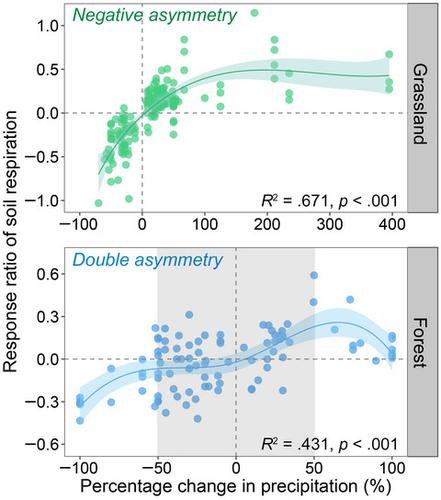当前位置:
X-MOL 学术
›
Glob. Change Biol.
›
论文详情
Our official English website, www.x-mol.net, welcomes your feedback! (Note: you will need to create a separate account there.)
The response of soil respiration to precipitation change is asymmetric and differs between grasslands and forests.
Global Change Biology ( IF 11.6 ) Pub Date : 2020-07-11 , DOI: 10.1111/gcb.15270 Yue Du 1 , Ying-Ping Wang 2 , Fanglong Su 1 , Jun Jiang 1 , Chen Wang 1 , Mengxiao Yu 1 , Junhua Yan 1
Global Change Biology ( IF 11.6 ) Pub Date : 2020-07-11 , DOI: 10.1111/gcb.15270 Yue Du 1 , Ying-Ping Wang 2 , Fanglong Su 1 , Jun Jiang 1 , Chen Wang 1 , Mengxiao Yu 1 , Junhua Yan 1
Affiliation

|
Intensification of the Earth's hydrological cycle amplifies the interannual variability of precipitation, which will significantly impact the terrestrial carbon (C) cycle. However, it is still unknown whether previously observed relationship between soil respiration (Rs) and precipitation remains applicable under extreme precipitation change. By analyzing the observations from a much larger dataset of field experiments (248 published papers including 151 grassland studies and 97 forest studies) across a wider range of precipitation manipulation than previous studies, we found that the relationship of Rs response with precipitation change was highly nonlinear or asymmetric, and differed significantly between grasslands and forests, between moderate and extreme precipitation changes. Response of Rs to precipitation change was negatively asymmetric (concave‐down) in grasslands, and double‐asymmetric in forests with a positive asymmetry (concave‐up) under moderate precipitation changes and a negative asymmetry (concave‐down) under extreme precipitation changes. In grasslands, the negative asymmetry in Rs response was attributed to the higher sensitivities of soil moisture, microbial and root activities to decreased precipitation (DPPT) than to increased precipitation (IPPT). In forests, the positive asymmetry was predominantly driven by the significant increase in microbial respiration under moderate IPPT, while the negative asymmetry was caused by the reductions in root biomass and respiration under extreme DPPT. The different asymmetric responses of Rs between grasslands and forests will greatly improve our ability to forecast the C cycle consequences of increased precipitation variability. Specifically, the negative asymmetry of Rs response under extreme precipitation change suggests that the soil C efflux will decrease across grasslands and forests under future precipitation regime with more wet and dry extremes.
中文翻译:

土壤呼吸对降水变化的响应是不对称的,在草原和森林之间是不同的。
地球水文循环的加剧加剧了降水的年际变化,这将大大影响陆地碳(C)循环。然而,仍然未知在极端降水变化下土壤呼吸(R s)与降水之间的关系是否仍然适用。通过分析更大范围的田间实验数据集(248篇论文,包括151项草地研究和97项森林研究)的观测结果,发现与以往的研究相比,其在更广泛的降水控制范围内,我们发现R s的关系降水变化的响应是高度非线性或不对称的,并且草原和森林之间,中度和极端降水变化之间存在显着差异。在草地上,R s对降水变化的响应为负不对称(凹形下降),在中等降水变化下,R s对降水的响应为非对称(凹形),在极端降水变化下为双不对称(凹形)。 。在草原,R s的负不对称性响应归因于土壤水分,微生物和根系活动对降水减少(DPPT)的敏感性高于对降水增加(IPPT)的敏感性。在森林中,正不对称性主要是由于中等IPPT下微生物呼吸的显着增加所致,而负不对称性则是由于极端DPPT下根系生物量的减少和呼吸的减少所致。草地和森林之间R s的不同非对称响应将大大提高我们预测降水变化增加的C周期后果的能力。具体而言,R s的负不对称性 极端降水变化下的响应表明,在未来的降水条件下,湿润和干燥极端条件下,草地和森林中的土壤碳流出将减少。
更新日期:2020-07-11
中文翻译:

土壤呼吸对降水变化的响应是不对称的,在草原和森林之间是不同的。
地球水文循环的加剧加剧了降水的年际变化,这将大大影响陆地碳(C)循环。然而,仍然未知在极端降水变化下土壤呼吸(R s)与降水之间的关系是否仍然适用。通过分析更大范围的田间实验数据集(248篇论文,包括151项草地研究和97项森林研究)的观测结果,发现与以往的研究相比,其在更广泛的降水控制范围内,我们发现R s的关系降水变化的响应是高度非线性或不对称的,并且草原和森林之间,中度和极端降水变化之间存在显着差异。在草地上,R s对降水变化的响应为负不对称(凹形下降),在中等降水变化下,R s对降水的响应为非对称(凹形),在极端降水变化下为双不对称(凹形)。 。在草原,R s的负不对称性响应归因于土壤水分,微生物和根系活动对降水减少(DPPT)的敏感性高于对降水增加(IPPT)的敏感性。在森林中,正不对称性主要是由于中等IPPT下微生物呼吸的显着增加所致,而负不对称性则是由于极端DPPT下根系生物量的减少和呼吸的减少所致。草地和森林之间R s的不同非对称响应将大大提高我们预测降水变化增加的C周期后果的能力。具体而言,R s的负不对称性 极端降水变化下的响应表明,在未来的降水条件下,湿润和干燥极端条件下,草地和森林中的土壤碳流出将减少。



























 京公网安备 11010802027423号
京公网安备 11010802027423号